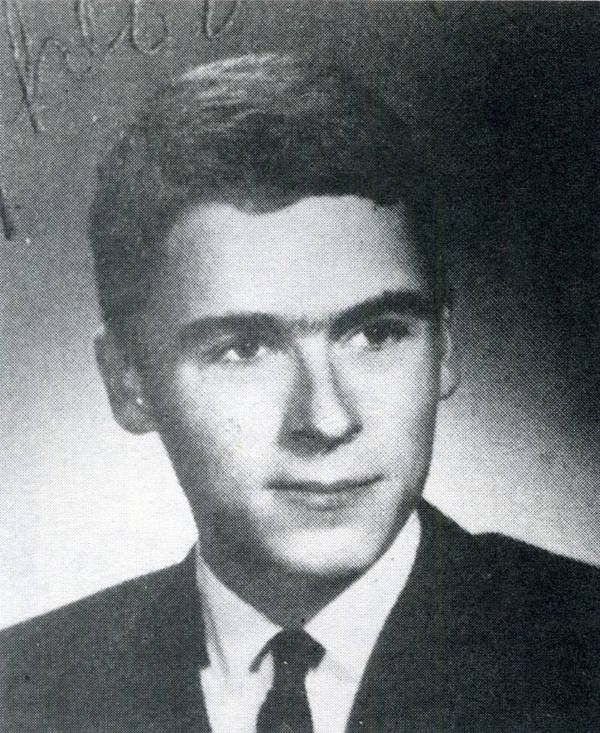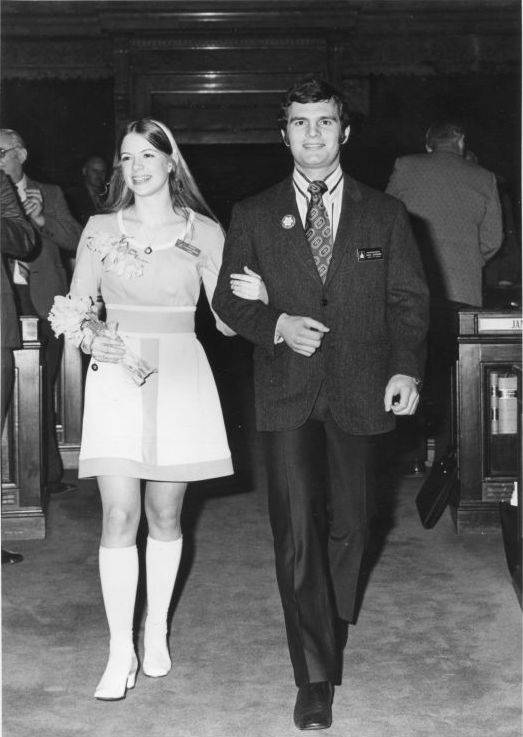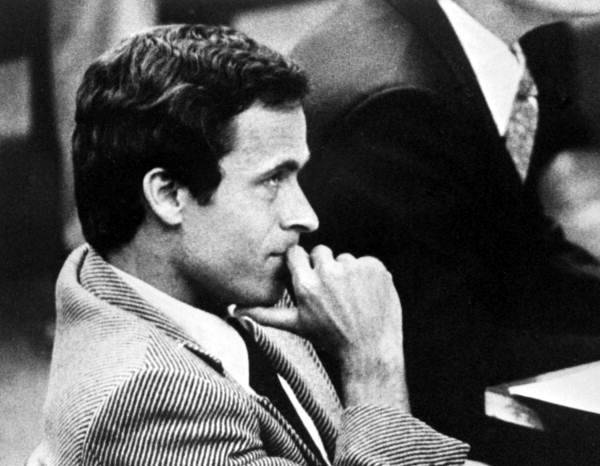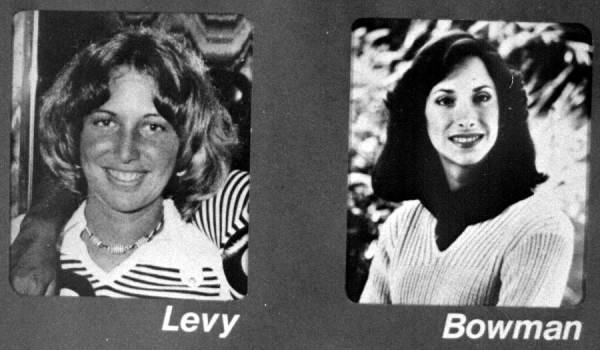Ted Bundy described himself as "the most cold-hearted son of a bitch you'll ever meet." His crimes certainly prove that statement true.
During the spring and summer of 1974, police in the Pacific Northwest were in a panic. Young women at colleges across Washington and Oregon were disappearing at an alarming rate, and law enforcement had few leads as to who was behind it.
In just six months, six women had been abducted. Panic in the area reached a fever pitch when Janice Ann Ott and Denise Marie Naslund disappeared in broad daylight from a crowded beach at Lake Sammamish State Park.

Bettmann/Contributor/Getty ImagesTed Bundy waves to television cameras during his trial for the assault and murder of several women in Florida in 1978.
But the boldest of the abductions also yielded the first real break in the case. On the day Ott and Naslund vanished, several other women remembered being approached by a man who had tried and failed to lure them to his car.
They told the authorities about an attractive young man with his arm in a sling. His vehicle was a brown Volkswagen Beetle, and the name he gave them was Ted.
After releasing this description to the public, the police were contacted by four people who identified the same Seattle resident: Ted Bundy.
These four people included Ted Bundy’s ex-girlfriend, a close friend of his, one of his co-workers, and a psychology professor who had taught Bundy.
But the police were inundated with tips, and they dismissed Ted Bundy as a suspect, thinking it unlikely that a clean-cut law student with no adult criminal record could be the perpetrator; he didn’t fit the profile.
These types of judgments benefitted Ted Bundy many times throughout his murderous career as one of history’s most infamous serial killers, which saw him take at least 30 victims across seven states in the 1970s.
For a time, he fooled everyone — the cops who didn’t suspect him, the prison guards whose facilities he escaped from, the women he manipulated, the wife who married him after he was caught — but he was, as his final lawyer said, “The very definition of heartless evil.”
As Ted Bundy himself once remarked, “I’m the most cold-hearted son of a bitch you’ll ever meet.”
Ted Bundy’s Childhood

Wikimedia CommonsTed Bundy’s high school yearbook photo. 1965.
Ted Bundy was born in Vermont, across the country from the Pacific Northwest communities he would one day terrorize.
His mother was Eleanor Louise Cowell and his father was unknown. His grandparents, ashamed of their daughter’s out-of-wedlock pregnancy, raised him as their own child. For nearly all of his childhood, he believed his mother to be his sister.
His grandfather would regularly beat both Ted and his mother, causing her to run away with her son to live with cousins in Tacoma, Washington, when Bundy was five years old. There, Eleanor met and married hospital cook Johnnie Bundy, who formally adopted the young Ted Bundy and gave him his last name.
Bundy disliked his step-father and would later describe him to a girlfriend disparagingly, saying he wasn’t very bright and didn’t make much money.
Little else is known for sure about the remainder of Bundy’s childhood, as he gave conflicting accounts of his early years to different biographers. In general, he described an ordinary life punctuated by dark fantasies that affected him powerfully — though the degree to which he acted on them remains unclear.
The reports of others are similarly confused. Though Bundy described himself as a loner who would stalk the seedy streets at night to spy on women, many who remember Bundy from high school describe him as reasonably well-known and well-liked.
Bundy’s College Years And His First Attack

Wikimedia CommonsTed Bundy. Circa 1975–1978.
Ted Bundy graduated from high school in 1965, then enrolled in the nearby University of Puget Sound. He spent just one year there before transferring to the University of Washington to study Chinese.
He dropped out briefly in 1968 but quickly re-enrolled as a psychology major. During his time out of school, he visited the East Coast, where he likely first learned that the woman he believed to be his sister was actually his mother.
Then, back at UW, Bundy started dating Elizabeth Kloepfer, a divorcée from Utah who worked as a secretary at the School of Medicine on campus. Later, Kloepfer was among the first to report Bundy to police as a suspect in the Pacific Northwest murders.
Also among the four people who gave police Bundy’s name was former Seattle police officer Ann Rule, who met Bundy at around this same time while they were both working at Seattle’s suicide hotline crisis center.
Rule would later write one of the definitive biographies of Ted Bundy, The Stranger Beside Me.
In 1973, Bundy was accepted into the University of Puget Sound Law School, but after a few months, he stopped attending classes.
Then, in January of 1974, the disappearances began.
Ted Bundy’s first known attack was not an actual murder, but instead an assault on 18-year-old Karen Sparks, a student and dancer at the University of Washington.
Bundy broke into her apartment and bludgeoned her unconscious with a metal rod from her bed frame before sexually assaulting her with the same object. His assault left her in a 10-day coma and with permanent disabilities.
Ted Bundy’s First Murders In Seattle

Personal photoTed Bundy victim Lynda Ann Healy.
Ted Bundy’s next victim and his first confirmed murder was Lynda Ann Healy, another UW student.
A month after his assault on Karen Sparks, Bundy broke into Healy’s apartment in the early morning, knocked her unconscious, then clothed her body and carried her out to his car. She was never seen again, but part of her skull was discovered years later at one of the locations where Bundy dumped his bodies.
Afterward, Bundy continued targeting female students in the area. He developed a technique: approaching women while wearing a cast or appearing otherwise disabled and asking them to help him put something in his car.
He would then bludgeon them unconscious before binding, raping, and killing them, dumping their bodies in a remote location in the woods. Bundy would often revisit these sites to have sex with their decaying corpses. In some cases, Bundy would decapitate his victims and keep their skulls in his apartment, sleeping beside his trophies.
“The ultimate possession was, in fact, the taking of the life,” Ted Bundy once said. “And then . . . the physical possession of the remains.”
“Murder is not just a crime of lust or violence,” he explained. “It becomes possession. They are part of you . . . [the victim] becomes a part of you, and you [two] are forever one . . . and the grounds where you kill them or leave them become sacred to you, and you will always be drawn back to them.”
Over the next five months, Bundy abducted and murdered five female college students in the Pacific Northwest: Donna Gail Manson, Susan Elaine Rancourt, Roberta Kathleen Parks, Brenda Carol Ball, and Georgann Hawkins.

Personal photosTed Bundy’s confirmed victims from January to June 1974.
Responding to this rash of disappearances, police called for a major investigation and enlisted a number of different government agencies to help look for the missing girls.
One of these agencies was the Washington State Department of Emergency Services, where Bundy worked. There, Bundy met Carole Ann Boone, a twice-divorced mother of two whom he would date on and off for years as the murders continued.
Relocation To Utah And Arrest For Kidnapping
As the manhunt for the abductor continued, more witnesses produced descriptions that matched Ted Bundy and his car. Just as some of Bundy’s victims’ bodies were being discovered in the woods, Bundy was accepted to law school in Utah and moved to Salt Lake City.
While living there, he continued to rape and murder young women, including a hitchhiker in Idaho and four teenage girls in Utah.

Personal photosThe women Ted Bundy killed in Utah in 1974.
Kloepfer was aware that Bundy had relocated to the area, and on learning of the Utah murders, she called the police a second time to reaffirm her suspicion that Bundy was behind the killings.
There was now a mounting pile of evidence pointing toward Ted Bundy, and when Washington investigators compiled their data, Bundy’s name appeared at the top of the suspect list.
Unaware of law enforcement’s growing interest in him, Bundy continued killing, journeying to Colorado from his home in Utah to murder more young women there.
Finally, in August 1975, Bundy was pulled over while driving through a Salt Lake City suburb, and police discovered masks, handcuffs, and blunt objects in the car. While this was not enough to arrest him, a police officer, realizing that Bundy was also a suspect in the earlier killings, put him under surveillance.

Kevin Sullivan/The Bundy Murders: A Comprehensive HistoryObjects found in Ted Bundy’s car.
The officers then found his Beetle, which he had since sold, where they discovered hair matching three of his victims. With this evidence, they put him in a lineup, where he was identified by one of the women whom he had attempted to abduct.
He was convicted of kidnapping and assault and sent to prison while police attempted to build a murder case against him.
Ted Bundy Escapes Jail In Aspen

Wikimedia CommonsTed Bundy in court in Florida in 1979.
But arrest didn’t stop Ted Bundy from killing.
He was soon able to, for the first of two times in his life, escape from custody.
In 1977, he escaped from the law library at the courthouse in Aspen, Colorado.
Because he was serving as his own lawyer, he had been allowed into the library during a break in his preliminary hearing. Nominally, he was researching the laws pertaining to his case. But the fact that he was his own counsel also meant he was unshackled — and when he saw his chance, he took it.
He jumped from the library’s second-floor window and hit the ground running, disappearing into the trees before the guard returned to check on him.
He planned to make his way toward Aspen Mountain, and he broke into a cabin and later a trailer for supplies. But resources were scarce, and it wasn’t long before he scrapped his plan to vanish into the wilderness.
Back in Aspen, he stole a car, thinking to put some distance between himself and the jail cell he was fleeing.
But the reckless speed with which Ted Bundy left Aspen made him conspicuous, and police officers spotted him. He was recaptured after six days of being on the run.
The Chi Omega Murders At Florida State
Ted Bundy’s next escape took place just six months later, this time from a jail cell.
After carefully studying a map of the prison, Bundy realized that his cell was directly beneath the living quarters of the prison’s chief jailer; the two rooms were separated only by a crawl space.
Bundy traded with another inmate to get a small hacksaw, and while his cellmates were exercising or showering, he worked away at the ceiling, scraping away layer after layer of plaster.
The crawl space he made was small — very small. He began deliberately cutting back on meals in an effort to lose weight.
He also planned ahead. Unlike last time, when his escape had failed because he was without resources in the outside world, he stowed away a small pile of money smuggled to him by Carole Ann Boone, the woman who would later marry him in prison.
When he was ready, Bundy finished the hole and crawled up into the chief jailer’s room. Finding it unoccupied, he swapped his prison jumpsuit for the man’s civilian clothes and strolled out the jail’s front doors.
This time, Ted Bundy didn’t dawdle; he stole a car immediately and got out of town, making his way to Florida.
Bundy’s Brutal Spree Of Attacks In Florida
It had been Ted Bundy’s intention to keep a low profile, but Florida life was presenting unexpected challenges. Unable to produce identification, he couldn’t get a job; he was back to grifting and stealing for money. And the compulsion toward violence was simply too strong.
On January 15, 1978, two weeks after his escape, Bundy broke into a Chi Omega sorority house on the Florida State University campus.
Within the span of just 15 minutes, he sexually assaulted and killed Margaret Bowman and Lisa Levy, bludgeoning them with firewood and strangling them with stockings. He then assaulted Kathy Kleiner and Karen Chandler, who both suffered horrific injuries, including broken jaws and missing teeth.
He then broke into the apartment of Cheryl Thomas, who lived several blocks away, and beat her so badly she lost her hearing permanently.

Wikimedia CommonsThe two women that Ted Bundy killed at FSU’s Chi Omega sorority house.
Still on the run on February 8, Ted Bundy abducted 12-year-old Kimberly Diane Leach from her middle school and murdered her, concealing her body on a pig farm.
And then, once again, his reckless driving caught the attention of the police. When they realized that his plates belonged on a stolen car, they pulled him over and found the IDs of three dead women in his vehicle, linking him to the FSU crimes.
“I wish you had killed me,” Bundy told the arresting officer.
The Trial And Execution Of Ted Bundy
Throughout his ensuing trial, Ted Bundy sabotaged himself by ignoring the advice of his lawyers and taking charge of his own defense. He unnerved even those assigned to work with him.
“I would describe him being as close to being like the devil as anyone I ever met,” said defense investigator Joseph Aloi.
Bundy was ultimately convicted and placed on death row at Florida’s Raiford Prison, where he suffered abuse from other prisoners (including a gang rape by four men, some sources say) and conceived a child with Carole Ann Boone, whom he’d married while he was on trial.
Ted Bundy was finally executed by electric chair on January 24, 1989. Hundreds of people gathered outside the courthouse to celebrate his death.
“For everything he did to the girls — the bludgeoning, the strangulation, humiliating their bodies, torturing them — I feel that the electric chair is too good for him,” said Eleanor Rose, the mother of victim Denise Naslund.

Bettmann/Getty ImagesFSU’s Chi Phi fraternity celebrates the execution of Ted Bundy with a large banner that says “Watch Ted Fry, See Ted Die!” as they prepare for an evening cookout where they will serve “Bundy burgers” and “electrified hot dogs.” 1989.
Though he confessed to many murders before his death, the true number of Bundy’s victims remains unknown. Bundy denied certain killings, despite physical evidence tying him to the crimes, and alluded to others that were never substantiated.
Ultimately, all of this has led authorities to suspect Ted Bundy killed anywhere from 30 to 40 women, making him one of the most infamous and terrifying serial killers in American history — and perhaps “the very definition of heartless evil.”
Next, learn how Ted Bundy helped police catch Gary Ridgway, perhaps America’s deadliest serial killer. Then, read up on Ted Bundy’s daughter Rose.






